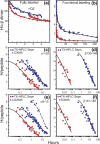Hydrogen exchange and mass spectrometry: A historical perspective
- PMID: 16876429
- PMCID: PMC3427778
- DOI: 10.1016/j.jasms.2006.06.006
Hydrogen exchange and mass spectrometry: A historical perspective
Abstract
Protein molecules naturally emit streams of information-rich signals in the language of hydrogen exchange concerning the intimate details of their stability, dynamics, function, changes therein, and effects thereon, all resolved to the level of their individual amino acids. The effort to measure protein hydrogen exchange behavior, understand the underlying chemistry and structural physics of hydrogen exchange processes, and use this information to learn about protein properties and function has continued for 50 years. Recent work uses mass spectrometric analysis together with an earlier proteolytic fragmentation method to extend the hydrogen exchange capability to large biologically interesting proteins. This article briefly reviews the advances that have led us to this point and the understanding that has so far been achieved.
Figures






References
-
- Hvidt A, Nielsen SO. Hydrogen exchange in proteins. Adv. Protein Chem. 1966;21:287–386. - PubMed
-
- Eigen M. Proton transfer, acid-base catalysis, and enzymatic hydrolysis. Angew. Chem. Int. Ed. English. 1964;3:1–19.
-
- Englander SW, Kallenbach NR. Hydrogen exchange and structural dynamics of proteins and nucleic-acids. Q. Rev. Biophys. 1984;16:521–655. - PubMed
-
- Perrin CL. Proton exchange in amides: Surprises from simple systems. Accts. Chem. Res. 1989;22:268–275.
Publication types
MeSH terms
Substances
Grants and funding
LinkOut - more resources
Full Text Sources
Other Literature Sources

